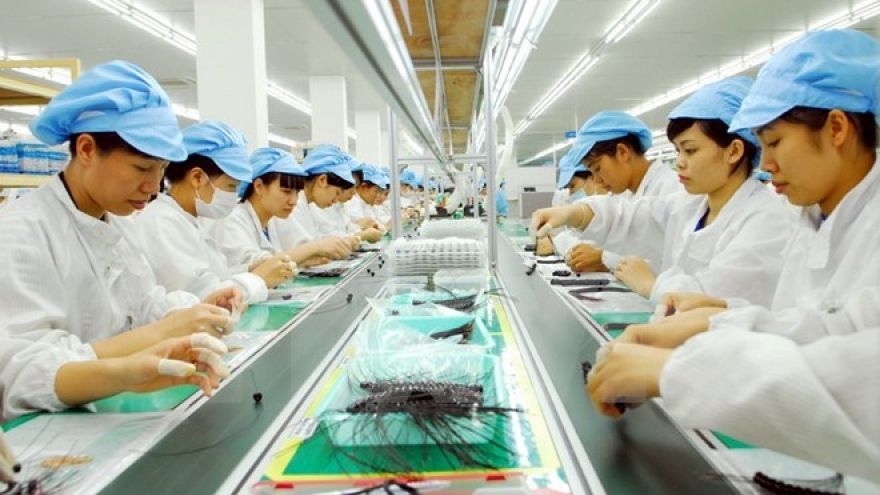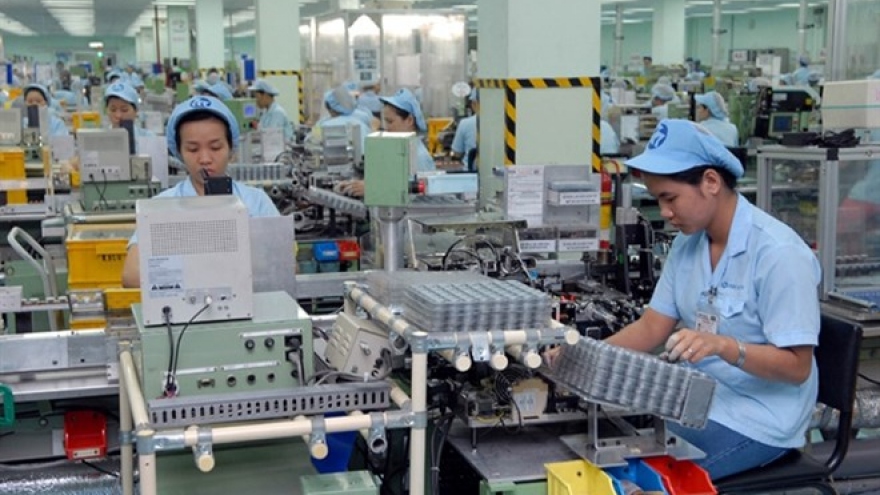FDI by sector and challenges: garnering interest
Apple has recently announced plans to invest in a new US$1 billion project in Vietnam sometime soon, and while the exact nature of the project is yet to be confirmed it is believed to be a research and development (R&D) center for its Asia operations.
Apple already has other R&D centers in the region, including China, Japan and Taiwan, and is preparing to open a new center in India.
Although not yet official, news that Apple will invest in Vietnam seems credible as last year it entered Vietnam’s electronics market with the establishment of the Apple Limited Co. in Ho Chi Minh City.
Vietnam is gradually becoming a high-tech base, with Apple joining Samsung, Microsoft and Intel in the country. Not only a center of technology investment, Vietnam also continues to attract foreign investors in sectors such as manufacturing and processing, real estate, and retail.
Leading the way
Manufacturing and processing and real estate are attracting the most interest from foreign investors.
Last year they invested in 19 sectors, of which manufacturing and processing was top, followed by power production and distribution, real estate, retail, and hotels and tourism.
Foreign investment in sectors such as education, agriculture, banking and finance, and health and social welfare remained limited.
Vietnam is becoming a global manufacturing and processing center.
 |
Each year more than US$10 billion in new FDI capital arrives in the sector.
An FIA report on Vietnam’s investment environment revealed that in 2015 manufacturing and processing attracted 955 new projects and additional capital in 517 existing projects, totaling US$15.23 billion and accounting for 66.9% of all FDI.
The manufacture and assembly of electronics equipment and components attracted substantial investment from major corporations.
According to Mr. Don Lam, CEO and Founding Partner of VinaCapital, FDI plays an important role in Vietnam’s economy as foreign-invested enterprises (FIEs) account for 70% of the country’s exports.
“Thanks to global multinational companies such as Samsung, Intel, Nike and others, Vietnam’s trade gap has narrowed in recent years, with surpluses recorded in the past few years,” he said. “FDI has also contributed to stronger foreign reserves.”
Vietnam is also seen as an ideal destination for real estate investors, according to a recent report from Cushman and Wakefield.
Last year real estate ranked third among sectors attracting FDI, with 34 new projects and 12 existing projects increasing their capital, for a total of US$2.39 billion, or 10.5% of all FDI capital.
According to Mr. Alex Crane, General Manager of Cushman & Wakefield Vietnam, there is continued demand from overseas investors at the institutional level and this will continue through 2016.
The number of merger and acquisition (M&A) deals saw a dramatic increase in 2015, of 20% compared to 2014, with real estate accounting for around 10% of the total FDI coming into the country.
“We haven’t yet seen much uptake at the individual level, especially in the residential sector, but Asian corporations in particular are aggressively active in Vietnam,” Mr. Crane said. “The market is becoming more competitive with local and foreign groups vying for the best sites and investments.”
Emerging industries
The textiles sector is forecast to catch the eyes of foreign investors as a series of free trade agreements (FTAs) and the TPP open up many opportunities for Vietnam.
The TPP is said to be especially beneficial for Vietnam, primarily because tariff barriers will be removed.
The US currently imposes tariffs on Vietnam’s textile products of between 17 and 20%, but after the TPP takes effect these tariffs will all fall to zero.
Many foreign textile investors are therefore expanding their investment in Vietnam to capture the opportunities.
Apart from big names such as Adidas and Nike deciding to increase production, many others have poured considerable amounts into the country.
For example, Turkey’s Hyosung Istanbul Tekstil Ltd invested US$660 million in the Hyosung Co. in Dong Nai province, producing and processing yarn, while a Hong Kong investor established Luthai Textiles with investment capital of US$170 million in southern Tay Ninh province.
Such projects are more often than not of large scale, whereas previously most were of small or medium scale and focused on outsourcing.
These new project are in producing textile materials, including dyeing, to meet the “yarn-forward” rule contained in the TPP, where inputs must come from member countries.
Foreign investment in retail, meanwhile, has also headed sharply upwards over recent years. Modern retail now accounts for 20 to 25% of consumption.
The Berli Jucker Public Company Limited (BJC) from Thailand aims to become the future retail giant in Vietnam, after last year spending US$876 million on purchasing Metro Cash & Carry Vietnam.
Other names targeting expansion in the country include Aeon Mall, Family Mart, and Lotte Mart, with many other Southeast Asian companies having also joined the market.
Shortcomings to address
Despite the positive results, Vietnam’s investment environment still bears a number of shortcomings.
According to a recent survey by the Japan Export Trade Research Organization (JETRO), over 60% of enterprises in Vietnam view the country’s underdeveloped legal framework and unclear implementation as a risk.
More than half also identified “increasing labor costs” and “time-consuming tax procedures” as issues.
Mr. Atsusuke Kawada, Chief Representative of JETRO, added time-consuming administrative procedures and insufficient infrastructure (power, logistics, and communications) as shortcomings Japanese investors must face.
The JETRO report showed that investors view these risks as being greater than previously.
“The localization rate of components in the manufacturing sector remaining low is also a difficulty for foreign companies,” Mr. Kawada said.
The overall localization rate stood at 32.1% in 2015, down slightly against 2014. While the rate is higher than that of the Philippines, at 26.2%, it is much lower than China’s 66%, Thailand’s 56%, and Indonesia’s 41%.
Difficulties are also found in the real estate sector.
The State Bank of Vietnam recently released a circular, Mr. Lam said, that may reduce lending to the real estate sector and result in a somewhat more challenging environment.
Local developers are now more capable than in the past and can compete with foreign developers more aggressively; something foreign developers need to be aware of if they are thinking of undertaking projects on their own.
Finally, a large number of condominium projects that were under construction over the last two years will be handed over to owners.
“It remains to be seen whether the majority of these buyers are end-users or investors, and too many investors could have a negative impact on the market,” he said.
Regardless, Vietnam is still forecast to continue to be an ideal destination for foreign corporations and companies.
There are a number of opportunities for real estate investors if they invest in the right product in terms of segment, pricing and location, Mr. Lam believes.
“The real estate market has emerged from a tough four or five years, but not all players are able to take advantage of this, especially in terms of financing,” he said.
“For a foreign investor Vietnam is unique, as it’s counter-cyclical compared to other real estate markets globally or in Asia, as most of them have seen tremendous price increases and are more likely to be at the top half of their cycles, while Vietnam has only been coming off the bottom for a year or so. From that perspective one could say that Vietnam is different and could offer diversification to investors.”
The JETRO survey also identified many positives in Vietnam’s investment environment. Profitable Japanese enterprises in the country make up approximately 60% and results achieved by non-manufacturing enterprises are relatively good.
More than 60% of Japanese enterprises in Vietnam are considering expansion plans.
“This is a higher rate than in other countries,” Mr. Kawada said. “Vietnam remains a vital destination for business development.”
The key motivation for expansion, as noted by 85% of respondents, is revenue increases, while 50% pointed to high growth and potential.
In non-manufacturing, the key motivation, as noted by up to 65% of respondents, is high growth and potential.
“We expect that FDI will continue strongly for the foreseeable future. Vietnamese workers are young and labor costs are competitive when compared to neighboring countries such as China. Companies from around the world have found Vietnam to be an attractive location for manufacturing. Beyond monetary investment, FDI companies also introduce new managerial practices and technological advances that can help raise workers’ productivity. We believe that Vietnamese enterprises can benefit from adopting such international best practices.”
Mr. Don Lam, CEO and Founding Partner of VinaCapital
“Many Japanese enterprises are now paying more attention to Vietnam’s consumption market. The Vietnamese Government has many policies to improve the investment environment but more important is how they are implemented. We hope the government will introduce further improvements to policy implementation to provide favorable conditions to investors.”
Mr. Atsusuke Kawada, Chief Representative of JETRO



